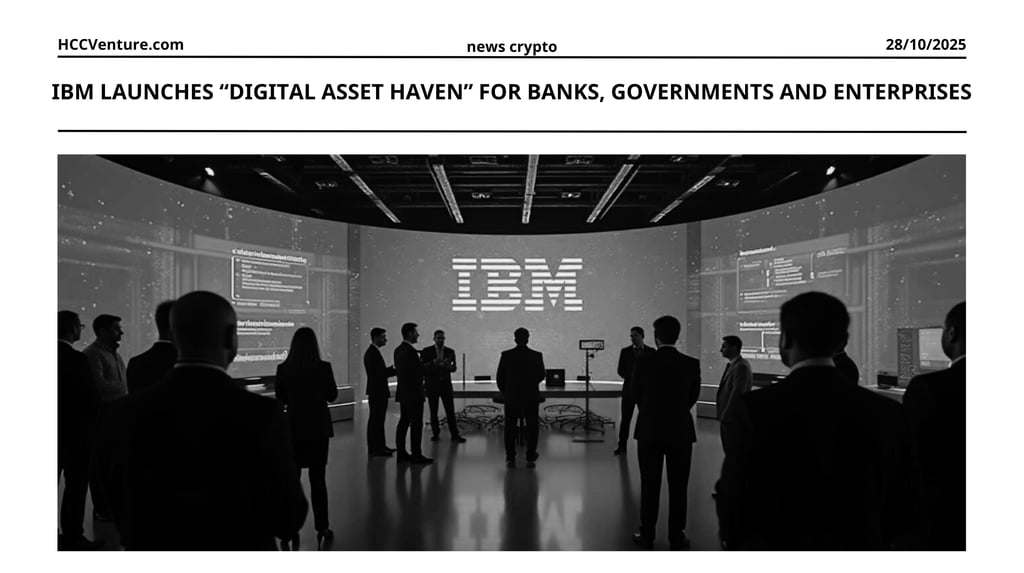IBM Launches “Digital Asset Haven” for Banks, Governments and Enterprises
IBM has officially entered the institutional digital asset infrastructure space with the launch of IBM Digital Asset Haven, a new platform designed for banks, businesses, and governments to manage custody.
10/28/20252 min read


What is Digital Asset Haven?
IBM, the computing giant synonymous with enterprise reliability, has entered the digital asset fray with the launch of Digital Asset Haven, a comprehensive platform tailored for banks, governments, and corporations to manage custody, trading, settlement, and compliance across more than 40 public and private blockchains.
Launched on Monday in partnership with wallet provider Dfns, the SaaS service — slated for a Q4 launch — combines IBM’s quantum-safe security with multi-party computation (MPC) for seamless encryption and payments, launching as institutional investment flows hit $70 billion year-to-date and tokenized RWAs surpass $62 billion in TVL.
Digital Asset Haven positions itself as the “operational backbone” for new institutional entrants to crypto, supporting the entire asset lifecycle from custody to settlement with enterprise-grade protections. Key pillars include:
MPC and Quantum-Safe Custody: Leveraging Dfns' wallet infrastructure, Haven uses hardware security modules (HSMs) and MPC to shard keys across nodes, ensuring there is no single point of failure - crucial as quantum threats emerge in 2030.
Interoperability with over 40 chains: From Ethereum and Solana to private ledgers like Hyperledger, Haven routes transactions with sub-second accuracy, enabling tokenized treasuries and stablecoin mints that comply with MiCA and SEC standards.
Regulatory Toolkit: Built-in KYC/AML screening, automated reporting to FATF, and programmable compliance with sanctions – tailored for governments like those experimenting with CBDCs.
Launching in Q4 2025 as pure SaaS, with hybrid options on IBM Z/LinuxONE for on-premises control, starting at $50,000 annually for mid-market banks.
IBM's new strategy for digital assets
As regulated institutions (banks, asset managers, governments) look to get involved with tokenized assets, IBM’s involvement provides a comprehensive infrastructure layer that integrates digital asset capabilities within traditional controls. This can lower the barriers for institutions to engage in on-chain custody, tokenization, stablecoins, payments, and settlements.
By integrating on more than 40 blockchains and providing security and compliance tools for enterprises, IBM is signaling that digital assets are moving from speculative markets to financial market infrastructure. This helps shift the perspective from “crypto as an add-on” to “crypto as infrastructure.”
IBM’s move puts pressure on existing fintech/crypto infrastructure providers (custodians, wallet providers, token issuance platforms) to improve their compliance, governance, and multi-chain capabilities. This could spur consolidation or collaboration at the infrastructure layer.
With a comprehensive lifecycle management process (issuance → custody → settlement → governance), organizations can build or implement tokenization use cases (stablecoins, tokenized deposits, asset-backed tokens, cross-border payments) with fewer problems to solve. IBM's platform can be the foundation for tokenization at scale.
Evaluation and Conclusion
IBM’s launch of Digital Asset Haven is more than just a product announcement — it’s a strategic milestone in the evolution of finance. It signals that tokenized assets are moving from the pilot stage to enterprise-grade infrastructure deployment, and large organizations now have a path to integrating blockchain-native finance without sacrificing control, compliance, or scale.
For traders, investors, and ecosystem builders, the bottom line is that infrastructure layers once occupied by niche crypto companies are now being developed by traditional tech giants — and that means institutional inflow and token adoption could accelerate faster than many expected.
Disclaimer: The information presented in this article is the author's personal opinion in the cryptocurrency field. It is not intended to be financial or investment advice. Any investment decision should be based on careful consideration of your personal portfolio and risk tolerance. The views expressed in this article do not represent the official position of the platform. We recommend that readers conduct their own research and consult with a professional before making any investment decisions.
Explore HCCVenture group
HCCVenture © 2023. All rights reserved.


Connect with us
Popular content
Contact to us
E-mail : holdcoincventure_contact@hccventure.com
Register : https://linktr.ee/holdcoincventure
Disclaimer: The information on this website is for informational purposes only and should not be considered investment advice. We are not responsible for any risks or losses arising from investment decisions based on the content here.


TERMS AND CONDITIONS • CUSTOMER PROTECTION POLICY
ANALYTICAL AND NEWS CONTENT IS COMPILED AND PROVIDED BY EXPERTS IN THE FIELD OF DIGITAL FINANCE AND BLOCKCHAIN BELONGING TO HCCVENTURE ORGANIZATION, INCLUDING OWNERSHIP OF THE CONTENT.
RESPONSIBLE FOR MANAGING ALL CONTENT AND ANALYSIS: HCCVENTURE FOUNDER - TRUONG MINH HUY
Read warnings about scams and phishing emails — REPORT A PROBLEM WITH OUR SITE.
